
Streamer Fishing On Rivers, by Ceri Thomas
An article by Ceri Thomas
It’s well known that anglers in the USA and Europe like to fish streamers. To back this up you will often see trophy shots on Social media, complete with exotically named flies hanging from the hooked jaws of oversized brown trout.
Despite the obvious proof that they work, here in the UK steamers have never really taken off as a ‘go-to’ river method; in fact, the idea of tossing a streamer or lure about on a British river is a bit repellent to those familiar with our cultured history of upstream dry fly fishing.
The truth of it is trout are opportunists and will eat literally anything that provides protein, not just small invertebrates. Rodents, leeches, snakes, smaller fish and even their own kind are all on the menu. Streamer fishing is just another method that imitates the larger food items on the trout’s menu.
Up and Across
Generally, when using a streamer I prefer to cast upstream and across, tight to far bank cover where trout are lying in wait under tree branches and in sheltered bays off the main flow. Twitch your fly back downstream in short jerks, interspersed with dead drifts. The natural escape vector of prey is always downstream, so this technique imitates the natural food movement well. Always be ready for a hit within the first few pulls.
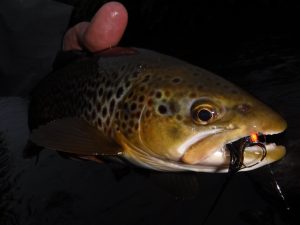
I usually find upstream streamer fishing to be more effective than a traditional ‘down and across’ throw. Takes are more solid, with less tail nipping and a better hook up ratio. Another advantage is there is far less chance of spooking your quarry. That said, don’t completely dismiss down and across, especially on a very wide stretch or in a fast run (see below).
Fast Water
By concentrating your efforts in fast water, you will have plenty of strikes to streamers. Here trout don’t get a chance to examine the fly closely, or have time to make an informed decision on whether this thing is edible or not! In such spots, it is easier to trigger a ‘fight or flight’ response by swinging a streamer through quickly.
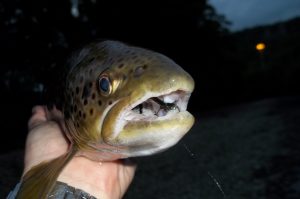
Fast water areas are best during bright, warm days in the summer when fish move into runs and riffles for cover and oxygen. Cast to the far side then let the fly swing around with the current. Occasionally give the fly line the odd sharp pull to induce interest. Remember fish will often follow the fly on a downstream swing for some time – so don’t be hasty to re-cast!
Special Conditions
Streamer fishing can be even more effective in certain special conditions. Bear these in mind and you will maximise your success.
River on the Rise
Floodwater conditions offer the perfect opportunity to fish streamers. In these conditions ‘normal’ fly fishing is simply not possible, but with a large dark or flashy streamer equipped with a heavy cone-head or tungsten bead, you have a chance of a fish noticing your fly, even in murky brown water. The addition of a bright red bead (think egg-sucking leech) is something that enhances a floodwater pattern even more.
On a flooded river look for slacks, back eddies, tree-lined bays and pool tails – basically anywhere out of the main flow where a trout could sit comfortably and pick off food. If you cannot hit the far bank then a cast just a few yards out into a back eddy under your feet will do. Remember the middle of the river is a dead zone when in flood – it is not likely to hold any fish if the river is pushing through hard. Retrieve wise, dead drift your flies and move them with an occasional twitch for best results.
In Low Light
Low light conditions are another prime time. Wild trout lose their caution at dawn and dusk. In the warm months especially, they will enter the shallows to hunt minnows, crayfish, leeches and caddis. They will also attack moths, mice and other creatures that swim across the river. This behaviour is more evident from late May until the season’s end, especially on overcast humid nights, so it really pays to stay on the river a while and rig up a streamer for late evening feeders. These same fish can also be found in the shallows at dawn during the summer months, should you prefer an early start.
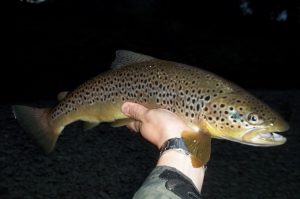
Prime areas to fish in low light include pool tails, long still flats and shallow, low gradient riffles – be prepared to find large fish in just inches of water. One late evening on the Taff I had a 20″ brown nail my offering in just 6 inches of water, an area completely devoid of fish in the day.
When fishing late I like to use a large, heavily hackled fly such as a woolly bugger, generally unweighted or with just a few turns of lead wire. Takes come from below at night, and the hackle helps keep the fly up in the water column, allowing the fly to drift and pulse whilst being silhouetted by the night sky. It is much akin to sea-trout fishing.
Don’t forget the hang – that final sweep and holding of the fly in the surface film just before re-casting. This is where a lot of takes come in low light. A big hackle helps with this, making a wake that the following fish will find hard to resist.
Streamer Setup
Personally, I like to use a fast action 9ft #5/6 rod, combined with a low-stretch fly line with an aggressive front taper (Airflo Xceed or Forty Plus floater are perfect). In extreme conditions such as high winds and floods, I have been known to use a 9ft #7 teamed with a sinking fly line, such as a Forty Plus fast intermediate or even a Di3 sinker.

On the business end, I find poly-leaders very useful for turnover and to help bed the fly down. A 5ft clear intermediate poly-leader with a 7ft tippet of 6 or 7lb Airflo G3 fluorocarbon usually works for me. Strength wise, I don’t go any lower than 6lb or use any ‘ultra-thin’ diameter stuff, as the risk of a break off gets higher, especially when fishing tight to snags and rocks that can chafe your leader. Generally, streamer eating trout do not tend to be tippet shy from experience anyway.
Streamer Flies
The image below (left to right) shows a selection of streamers suitable for the river. The general rule is to match the fly size to the conditions. Big water = bigger fly. I have graded them from small to large as follows:
Jig bugger (size 12) – Low flows, can also be used on a French leader
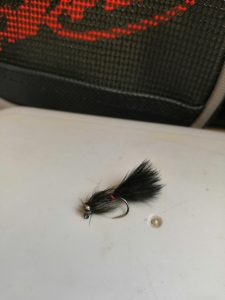
CT Tungsten bugger (size 10) – General use, clear water
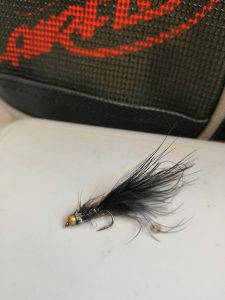
Egg sucking leech (size 10) – Works well in slightly stained water or fast flows
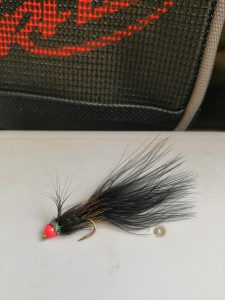 Large woolly bugger (size 8) – Low light
Large woolly bugger (size 8) – Low light
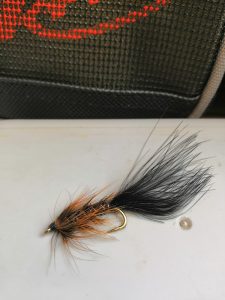
Goldie (Size 6 wide)- Coloured water, flood conditions
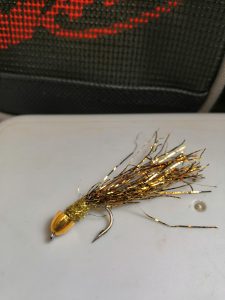 Large Skull-head bugger (size 4) – Coloured water, flood conditions
Large Skull-head bugger (size 4) – Coloured water, flood conditions
When All Else Fails…
Sometimes the trout just won’t have it. The river seems dead, nothing is rising, whatever you try is just ignored and it seems a blank is inevitable. This is when a streamer could turn your day around. Try it, you have nothing to lose… right?
For some reason, on certain days river trout simply ‘like’ to eat streamers – I have no explanation for it, but if they are ‘on’ you can have a superb day. So before you pack up it is always worth making some prospective casts with a streamer, just to see if they are in the mood.
 This also includes picky rising trout – you know, the sort that has refused every fly in the box down to a size 22. If you have exhausted all other options, then why not cast a streamer over it just to see what happens? It will either put the fish down or sometimes result in a violent take and a saved day.
This also includes picky rising trout – you know, the sort that has refused every fly in the box down to a size 22. If you have exhausted all other options, then why not cast a streamer over it just to see what happens? It will either put the fish down or sometimes result in a violent take and a saved day.
Overall the key with streamer fishing is never to linger, be confident and cover lots of water – you will eventually find an aggressive trout willing to hit your lure. When it does, it could be a fish to truly remember.
WHY NOT JOIN US?
The Gwent Angling Society is a progressive, conservation-minded club offering fishing on six beats on the River Usk, two on the River Wye, the Sirhowy river and Afon Llynfi (Powys), and the wonderful Talybont Reservoir. Our waters can be viewed here. If you are interested in joining us or have any queries, simply contact our Membership Secretary.



